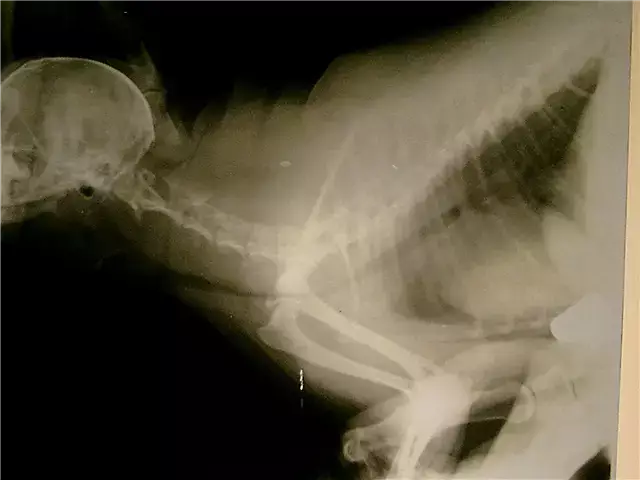- Author Rachel Wainwright [email protected].
- Public 2023-12-15 07:39.
- Last modified 2025-11-02 20:14.
Ethinylestradiol
Instructions for use:
- 1. Pharmacological action
- 2. Release form
- 3. Indications for use
- 4. Contraindications
- 5. Method of application
- 6. Drug interactions
- 7. Side effects
- 8. Storage conditions
Ethinylestradiol is a hormonal agent used to treat diseases caused by estrogen deficiency.
pharmachologic effect
The active component of Ethinylestradiol causes endometrial proliferation and promotes more intensive development of the fallopian tubes, uterus, as well as secondary female sexual characteristics in cases of underdevelopment. This allows you to mitigate or eliminate completely in the female body the consequences that arise as a result of insufficient function of the sex glands.
In addition, the active substance Ethinylestradiol:
- Has a mild anabolic effect;
- Causes sodium and water retention (when used in high doses);
- Has a hypocholesterolemic effect (helps to reduce blood cholesterol levels);
- Increases calcium absorption and promotes the formation of calcium stores in bones.
Release form
The drug Ethinylestradiol is produced in the form of tablets of 10 and 50 μg.
By the mechanism of action, ethinylestradiol analogues include: Divigel, Klimara, Ovestin, Sinestrol, Elvagin, Estrogel, Estrovagin, Ovipol Clio, Estrokad.
As an active component, Ethinylestradiol is a part of such combination drugs as Marvelon, Mersilon, Lindinet 20, Chloe, Rigevidon, Bellune 35, Microfollin, Novinet, Yarina, Tri-regol, Rigevidon, Lindinet 30, Triziston, Genetten, Triquilar, Logest, Jannine, Jess, Femoden, Midiana.
Indications for the use of Ethinylestradiol
According to the instructions, Ethinylestradiol is prescribed for the treatment of:
- Ovarian hypofunction (dysmenorrhea, primary and secondary amenorrhea, oligomenorrhea, hypomenorrhea);
- Androgen-dependent prostate cancer;
- Infertility;
- Metrorrhagia (including therapy in the climacteric period);
- Hypogonadism;
- Vaginitis (both in girls and in the postmenopausal period);
- Some forms of breast cancer;
- Secondary estrogen deficiency;
- Sexual infantilism;
- Acne;
- Post-castration and climacteric disorders.
In addition, Ethinylestradiol is used to suppress lactation after childbirth, and as part of combination drugs - for contraception.
Contraindications Ethinylestradiol
Ethinylestradiol is contraindicated for:
- Breast cancer and other estrogen-dependent neoplasms;
- History of herpes in pregnant women;
- Vaginal bleeding of unknown origin;
- Pregnancy and lactation;
- Endometriosis;
- Severe cardiovascular disease;
- Thrombosis and thromboembolism;
- Sickle cell anemia;
- Liver failure.

Care must be taken when taking Ethinylestradiol against the background of:
- Epilepsy;
- Bronchial asthma;
- Diseases of the heart and kidneys;
- Migraine;
- Hypercalcemia;
- Otosclerosis;
- Arterial hypertension;
- Systemic lupus erythematosus;
- Multiple sclerosis.
Method of application of ethinylestradiol
The dosage of Ethinylestradiol and the duration of its use depend on the indications.
With oligomenorrhea and amenorrhea, as a rule, Ethinylestradiol is prescribed in a daily dosage of 0.02-0.1 mg for twenty days.
With dysmenorrhea, one to three tablets (10 mcg) per day are indicated for twenty days (starting from 4-5 days of the menstrual cycle). The treatment is effective within 2-3 months.
For menopausal disorders, women under 45 take 0.05 mg per day.
Treatment with Ethinylestradiol for cancer (both breast in women over 60 years of age, and prostate) is usually long-term. A single dose ranges from 0.05 to 0.1 mg three times a day. As a rule, treatment is combined with radiation therapy.
In the treatment of acne, from 3 to 6 tablets (10 mcg) are prescribed per day, during puberty - from one to three tablets.
When using Ethinylestradiol to suppress lactation, 0.02 mg is taken three times a day for the first three days after childbirth, after which the dosage is gradually reduced. The total duration of ethinylestradiol administration is usually 9 days.
Drug interactions
During the therapy with Ethinylestradiol, it should be borne in mind that the estrogens that make up the drug reduce the effects of anticoagulants, as well as hypoglycemic and antihypertensive drugs.
Side effects of Ethinylestradiol
According to reviews, Ethinylestradiol can cause disorders of various body systems, namely:
- Hyperpigmentation of the skin (dermatological reactions);
- Change in libido, soreness and enlargement of the mammary glands, decreased glucose tolerance (endocrine system);
- Dysfunction of the gastrointestinal tract, nausea, vomiting, abnormal liver function, jaundice (digestive system);
- An increased tendency to thrombosis (circulatory system);
- Headache, depression, dizziness, migraine (nervous system);
- Weight gain and edema (metabolism).
Storage conditions
Ethinylestradiol belongs to a number of hormonal drugs in List B with a recommended shelf life of 24 months.
Information about the drug is generalized, provided for informational purposes only and does not replace the official instructions. Self-medication is hazardous to health!






